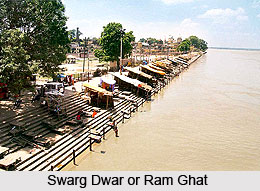 Swarg Dwar, or Ram Ghat as it is also known as, is located half a kilometre north of Janmabhoomi. This is an important bathing Ghat. As per Indian mythology, Lord Rama is also said to have been cremated here. The strip of land from Sahasradhara to Nageshwarnath Temple is commonly symbolized as Swarg Dwar. On the river front is Swarga Dwara where according to some accounts, Rama"s body was cremated.
Swarg Dwar, or Ram Ghat as it is also known as, is located half a kilometre north of Janmabhoomi. This is an important bathing Ghat. As per Indian mythology, Lord Rama is also said to have been cremated here. The strip of land from Sahasradhara to Nageshwarnath Temple is commonly symbolized as Swarg Dwar. On the river front is Swarga Dwara where according to some accounts, Rama"s body was cremated.
Rama Ghat is associated with Rama Teertham and the shrine of Vira Ramesvara. The major shrines on this ghat are Rama Temple and Badi - Narayana Temple. Kala Ganga and Tamra Varaha are the nearest Teerthams. Nearby this ghat is Sanga Veda School, a famous Veda school, where special celebrations are held during the birthdays of Lord Ram and Lord Ganesha.
The narrow piece of land from Sahasradhara to Nageshwarnath temple is commonly symbolized as Swarg Dwar in Ayodhya. One can see the buildings on the Ghat facing Sarayu River. They were primarily built by the Hindu Nawab Naval Rai, in the court of king Safdar Jung in 18th century. The buildings on the Ghats are very fine to view from a distance. But the river bed has shifted northwards, in recent past taking a departure from the old the Ghats. During 1960s the present new Ghats were constructed next to the new bridge, which give an excellent view to look at.
Controversies of Rama Ghat
Controversies are many in the stories based on epics, Puranas and sacred scripts. Many incidents or stories do not stand to logic or scientific analysis. The pundits are unable to answer. But they don"t admit the follies; on the other hand they brand the one who poses such question as an Atheist. The epic and other stories based on Ramayana say that after crowning his sons Rama went to Vaikunth, his abode, with human body. Contrary to this here is a spot called Swarg Dwar which is said to be the place where Rama was cremated.
One may find several such Swarga Dwaras in Indian pilgrimage centres like Dwarka, Puri Jagannath and etc. There is a Swarga Dwar Ashram in Himalayas. In Ayodhya Swarg Dwar is the spot where Lord Rama was cremated.
Ayodhya: Ram Janmabhoomi
Faizabad in Ayodhya is a popular pilgrim centre not only for Hindus but also for all those who have reverence to Lord Sri Rama, the seventh incarnation of Lord Vishnu. Manu, the first king of mankind founded the city of Ayodhya. He was the law giver and even today many of his prescriptions are followed by Hindus and they are part of ancient Hindu law as recorded by Sir Henry Mynes, who is an authoritative writer on Hindu Law. It was the capital of the kings of Surya dynasty for centuries. Rama was the most distinguished king among them. Kaushal kingdom was the other name for Ayodhya during Treta Yug.
Ayodhya is the legendary place where god Rama was born and it is also sometimes referred to as Ram Janmabhoomi; "Rama`s birth place". The modern town is located on the banks of river Sarayu, also spelt Sarju. There is a surfeit of temples in this town, numbering over 100. Some of the important ones are: Temple of Rama and his consort Sita, called the "Kanak Bhavan"; Hanuman temple called the "Hanuman Garhi" on top of a hill where, apart from a Hanuman statue in a sitting posture, there is also a tall image of Hanuman always bedecked by flowers; the "Kshireshwaranath Temple" of Sita, established by Kausalya, Rama`s mother. In addition, there are several kunds or ponds and ghats with linkage to mythological characters; such as the Brahma Kund built in honour of Brahma`s visit here, Sita Kund, Bharat Kund, Lakshman ghat where Lakshman, Rama`s brother took bath.



















